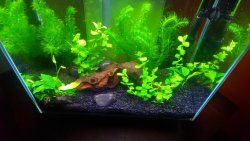Hey all,
So i finally managed to locate a table for my tank and managed to get it set up over the weekend. I went to my LFS and purchased some live plants and also a nice piece of bogwood from one of their established tanks (which had a rather peculiar looking zebra plec inside it!)
After reading this thread http /forum.practicalfishkeeping.co.uk/archive/index.php/t-99848.html I decided to use the Nutrafin start up solution that came with the tank.
/forum.practicalfishkeeping.co.uk/archive/index.php/t-99848.html I decided to use the Nutrafin start up solution that came with the tank.
So tank up and running on Saturday and I took some initial measurements after two or three hours.
ph - 5
Ammonia - 0.6
Nitrite - 0
Today
ph 6
Ammonia - 1.2
Nitrite - 0
I assume I am also getting some ammonia kick from the bogwood.
So....questions...
Does this look about right for what I should see happening? I have read MANY people saying that the kick start solutions are rubbish but it seems to have worked for the guy from the link above.
I am keen to continue with the cycle using the solution (last dose tomorrow). Should I just monitor ammonia levels to see if they increase? And if not, abandon ship and purchase some 'pure' ammonia?
So i finally managed to locate a table for my tank and managed to get it set up over the weekend. I went to my LFS and purchased some live plants and also a nice piece of bogwood from one of their established tanks (which had a rather peculiar looking zebra plec inside it!)
After reading this thread http
 /forum.practicalfishkeeping.co.uk/archive/index.php/t-99848.html I decided to use the Nutrafin start up solution that came with the tank.
/forum.practicalfishkeeping.co.uk/archive/index.php/t-99848.html I decided to use the Nutrafin start up solution that came with the tank.So tank up and running on Saturday and I took some initial measurements after two or three hours.
ph - 5
Ammonia - 0.6
Nitrite - 0
Today
ph 6
Ammonia - 1.2
Nitrite - 0
I assume I am also getting some ammonia kick from the bogwood.
So....questions...
Does this look about right for what I should see happening? I have read MANY people saying that the kick start solutions are rubbish but it seems to have worked for the guy from the link above.
I am keen to continue with the cycle using the solution (last dose tomorrow). Should I just monitor ammonia levels to see if they increase? And if not, abandon ship and purchase some 'pure' ammonia?



